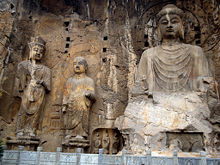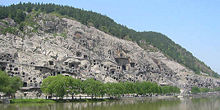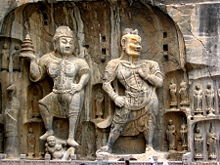Difference between revisions of "Longmen Grottoes" - New World Encyclopedia
Dan Davies (talk | contribs) |
Dan Davies (talk | contribs) |
||
| Line 33: | Line 33: | ||
[[Image:LongmenBoddhi.jpg|right|thumb|220px|Massive [[Boddhisatva]]s in the main grotto.]] | [[Image:LongmenBoddhi.jpg|right|thumb|220px|Massive [[Boddhisatva]]s in the main grotto.]] | ||
===Northern Wei=== | ===Northern Wei=== | ||
| − | '''Middle Binyang Cave''' ([[Chinese language|ch.]] 宾阳中洞) is cave number 140, 12 meters long, 10.9 meters wide, 9.3 meters high. Constructed by order of [[Emperor Xuanwu of Northern Wei China|Emperor Xuanwu]] of the [[Northern Wei]] in | + | ===='''Middle Binyang Cave'''==== |
| + | Middle Binyang Cave ([[Chinese language|ch.]] 宾阳中洞) is cave number 140, 12 meters long, 10.9 meters wide, 9.3 meters high. Constructed by order of [[Emperor Xuanwu of Northern Wei China|Emperor Xuanwu]] of the [[Northern Wei]] in honor of his parents [[Emperor Xiaowen of Northern Wei China|Emperor Xiaowen]] and [[Empress Wenzhao of Northern Wei China|Empress Wenzhao]], the cave was supposed to imitate [[Lingyansi Cave]] at the [[Yungang Caves]]. Work began in 500 and was completed in 523. In 1987 a brick-entrance was demolished to reveal two new figures: a four-headed, four-armed [[Brahma (Buddhism)|Brahma]] and a one headed, four armed [[Śakra]] devendra. | ||
The back wall is a carved [[Sakyamuni]], with two discliples and two [[bodhisattva]]s. The main Buddha and bodhisattvas are representative of the Northern Wei sculptural style. A lotus-flower pool decorates the floor. The ceiling is engraved with a blossoming lotus flower, 8 musical [[apsaras]]es, 2 attending apsarases and tassel and drapery patterns. The front wall is covered with a large [[Vimalakirti]] relief, the [[Prince Sattva]] [[jataka]], the [[Prince Sudatta]] jataka, an emperor/empress worshipping scene and ten deity kings. The cave is flanked by [[North Binyang Cave|North]] and [[South Binyang Cave|South]] Binyang Caves. | The back wall is a carved [[Sakyamuni]], with two discliples and two [[bodhisattva]]s. The main Buddha and bodhisattvas are representative of the Northern Wei sculptural style. A lotus-flower pool decorates the floor. The ceiling is engraved with a blossoming lotus flower, 8 musical [[apsaras]]es, 2 attending apsarases and tassel and drapery patterns. The front wall is covered with a large [[Vimalakirti]] relief, the [[Prince Sattva]] [[jataka]], the [[Prince Sudatta]] jataka, an emperor/empress worshipping scene and ten deity kings. The cave is flanked by [[North Binyang Cave|North]] and [[South Binyang Cave|South]] Binyang Caves. | ||
| − | |||
| − | |||
| − | |||
<center> | <center> | ||
<gallery> | <gallery> | ||
| Line 51: | Line 49: | ||
{{credits|Middle_Binyang_Cave|190478319|}} | {{credits|Middle_Binyang_Cave|190478319|}} | ||
—> | —> | ||
| − | *[[Lotus-flower Cave]] | + | ====Other Northern Wei grottoes==== |
| − | *[[Weizi Cave]] | + | * [[Guyang Cave]] |
| − | *[[Huangfugong Cave]] | + | * [[Lotus-flower Cave]] |
| + | * [[Weizi Cave]] | ||
| + | * [[Huangfugong Cave]] | ||
===Sui=== | ===Sui=== | ||
Revision as of 22:44, 2 October 2008
Coordinates:
| Longmen Grottoes* | |
|---|---|
| UNESCO World Heritage Site | |

| |
| State Party | |
| Type | Cultural |
| Criteria | i, ii, iii |
| Reference | 1003 |
| Region** | Asia-Pacific |
| Inscription history | |
| Inscription | 2000 (24th Session) |
| * Name as inscribed on World Heritage List. ** Region as classified by UNESCO. | |
The Longmen Grottoes (ch. 龍門石窟/ 龙门石窟, lóngmén shíkū; lit. Dragon's Gate Grottoes) or Longmen Caves are located 12 km south of present day Luoyang in Henan province, China. The grottoes, which overwhelmingly depict Buddhist subjects, are densely dotted along the two mountains: Xiangshan (to the east) and Longmenshan (to the west). The Yi River flows northward between them. For this reason, the area used to be called Yique (The Gate of the Yi River). From north to south, the distance covered by grottoes is about one km. Along with the Mogao Caves and Yungang Grottoes, the Longmen Grottoes are one of the three most famous ancient sculptural sites in China.
Description
According to the Longmen Caves Research Institute, 2345 caves and niches, 2800 inscriptions, forty three pagodas and over 100,000 Buddhist images populate the site. Thirty percent of the caves date from the Northern Wei Dynasty, sixty percent from the Tang Dynasty, and caves from other periods less than ten percent. The most impressive collection of Chinese art from those dynasties, dating from 316 to 907 C.E., they represent the zenith of stone carving in China.[1] The area was inscribed on the UNESCO World Heritage List in November 2000.
History
During the Warring States Period, the general Bai Qi of Qin (state) once defeated the allied forces of Han (state) and Wei (state) at the site. Construction of the grottoes themselves began in 493 C.E. According to the inscription the Longmen Grottoes are an illustration of "...the perfection of a long-established art form which was to play a highly significant role in the cultural evolution of this region of Asia."[1]
Individual grottoes by dynasty completed
Northern Wei
Middle Binyang Cave
Middle Binyang Cave (ch. 宾阳中洞) is cave number 140, 12 meters long, 10.9 meters wide, 9.3 meters high. Constructed by order of Emperor Xuanwu of the Northern Wei in honor of his parents Emperor Xiaowen and Empress Wenzhao, the cave was supposed to imitate Lingyansi Cave at the Yungang Caves. Work began in 500 and was completed in 523. In 1987 a brick-entrance was demolished to reveal two new figures: a four-headed, four-armed Brahma and a one headed, four armed Śakra devendra.
The back wall is a carved Sakyamuni, with two discliples and two bodhisattvas. The main Buddha and bodhisattvas are representative of the Northern Wei sculptural style. A lotus-flower pool decorates the floor. The ceiling is engraved with a blossoming lotus flower, 8 musical apsarases, 2 attending apsarases and tassel and drapery patterns. The front wall is covered with a large Vimalakirti relief, the Prince Sattva jataka, the Prince Sudatta jataka, an emperor/empress worshipping scene and ten deity kings. The cave is flanked by North and South Binyang Caves.
Other Northern Wei grottoes
- Guyang Cave
- Lotus-flower Cave
- Weizi Cave
- Huangfugong Cave
Sui
- South Binyang Cave (159)
Tang
- Fengxiansi
- 10,000 Buddha Cave
- Hidden Stream Temple Cave (20)
- Kanjingsi
- Dawanwufo Cave
- North Binyang Cave (104)
The Longmen area is open to the public, and although the grottoes cannot be entered most of the artwork can be seen from the exterior.
Notes
- ↑ 1.0 1.1 Longmen Grottoes. UNESCO. Retrieved 2008-10-02.
ReferencesISBN links support NWE through referral fees
| |||||||
External Links
Credits
New World Encyclopedia writers and editors rewrote and completed the Wikipedia article in accordance with New World Encyclopedia standards. This article abides by terms of the Creative Commons CC-by-sa 3.0 License (CC-by-sa), which may be used and disseminated with proper attribution. Credit is due under the terms of this license that can reference both the New World Encyclopedia contributors and the selfless volunteer contributors of the Wikimedia Foundation. To cite this article click here for a list of acceptable citing formats.The history of earlier contributions by wikipedians is accessible to researchers here:
The history of this article since it was imported to New World Encyclopedia:
Note: Some restrictions may apply to use of individual images which are separately licensed.






